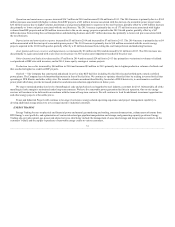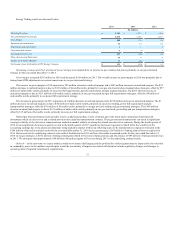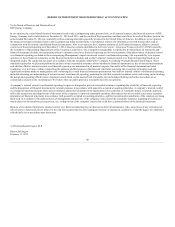DTE Energy 2014 Annual Report Download - page 43
Download and view the complete annual report
Please find page 43 of the 2014 DTE Energy annual report below. You can navigate through the pages in the report by either clicking on the pages listed below, or by using the keyword search tool below to find specific information within the annual report.
The value of our qualified pension and other postretirement benefit plan assets was $5.5 billion at December 31, 2014 and $5.2 billion at December 31,
2013. At December 31, 2014, our qualified pension plans were underfunded by $1.17 billion and our other postretirement benefit plans were underfunded by
$517 million. The 2014 funding levels generally declined due to decreased discount rates and a change in the mortality tables.
Pension and other postretirement costs and pension cash funding requirements may increase in future years without typical returns in the financial
markets. We made contributions to our qualified pension plans of $188 million in 2014 and $277 million in 2013. At the discretion of management,
consistent with the Pension Protection Act of 2006, and depending upon financial market conditions, we anticipate making contributions to our qualified
pension plans of up to $180 million in 2015 and up to $875 million over the next five years. We made other postretirement benefit plan contributions of
$24 million in 2014 and $264 million in 2013. We are required by orders issued by the MPSC to make other postretirement benefit contributions at least
equal to the amounts included in our utilities' base rates. As a result, we anticipate making up to a $200 million contribution to our other postretirement plans
in 2015 and, subject to MPSC funding requirements, up to $250 million over the next five years. The planned contributions will be made in cash or a
combination of cash and DTE Energy common stock.
See Note 18 to the Consolidated Financial Statements in Item 8 of this Report, "Retirement Benefits and Trusteed Assets".
We are involved in various legal proceedings, claims and litigation arising in the ordinary course of business. We regularly assess our liabilities and
contingencies in connection with asserted or potential matters, and establish reserves when appropriate. Legal reserves are based upon management’s
assessment of pending and threatened legal proceedings and claims against us.
Our comprehensive insurance program provides coverage for various types of risks. Our insurance policies cover risk of loss including property
damage, general liability, workers’ compensation, auto liability, and directors’ and officers’ liability. Under our risk management policy, we self-insure
portions of certain risks up to specified limits, depending on the type of exposure. The maximum self-insured retention for various risks is $10 million for
property damage, $7 million for general liability, $9 million for workers’ compensation and $7 million for auto liability. We have an actuarially determined
estimate of our incurred but not reported (IBNR) liability prepared annually and we adjust our reserves for self-insured risks as appropriate. As of
December 31, 2014, this IBNR liability was approximately $32 million.
We are required to make judgments regarding the potential tax effects of various financial transactions and results of operations in order to estimate our
obligations to taxing authorities. We account for uncertain income tax positions using a benefit recognition model with a two-step approach, a more-likely-
than-not recognition criterion and a measurement attribute that measures the position as the largest amount of tax benefit that is greater than 50% likely of
being realized upon ultimate settlement. If the benefit does not meet the more likely than not criteria for being sustained on its technical merits, no benefit
will be recorded. Uncertain tax positions that relate only to timing of when an item is included on a tax return are considered to have met the recognition
threshold. We also have non-income tax obligations related to property, sales and use and employment-related taxes and ongoing appeals related to these tax
matters.
Accounting for tax obligations requires judgments, including assessing whether tax benefits are more likely than not to be sustained, and estimating
reserves for potential adverse outcomes regarding tax positions that have been taken. We also assess our ability to utilize tax attributes, including those in the
form of carry-forwards, for which the benefits have already been reflected in the financial statements. We believe the resulting tax reserve balances as of
December 31, 2014 and 2013 are appropriate. The ultimate outcome of such matters could result in favorable or unfavorable adjustments to our consolidated
financial statements and such adjustments could be material.
See Note 9 to the Consolidated Financial Statements in Item 8 of this Report, "Income Taxes".
See Note 3 to the Consolidated Financial Statements in Item 8 of this Report, "New Accounting Pronouncements".
41
























